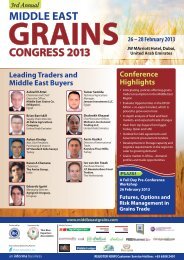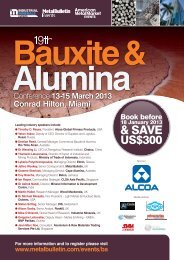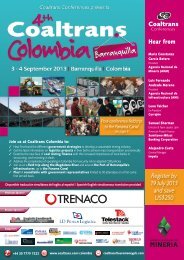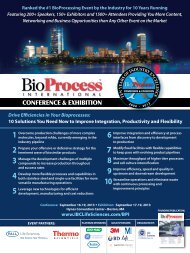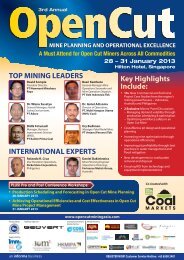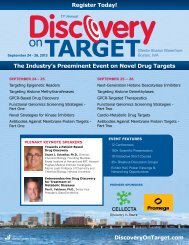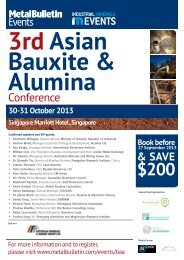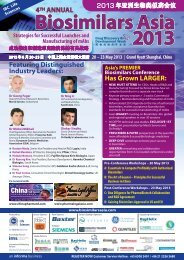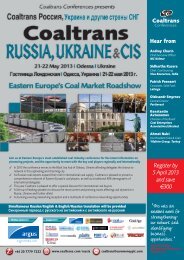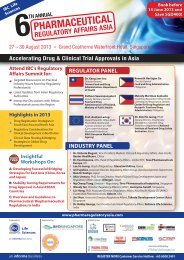Cell Line Development & Engineering
Cell Line Development & Engineering
Cell Line Development & Engineering
You also want an ePaper? Increase the reach of your titles
YUMPU automatically turns print PDFs into web optimized ePapers that Google loves.
Monday, May 20, 2013<br />
7:00 Registration and Coffee<br />
8:00 Chairwoman’s Opening Remarks – The Legal, Regulatory<br />
and Technical Landscape<br />
Laurie Donahue-Hjelle, Ph.D., Director, New Product <strong>Development</strong>,<br />
Life Technologies<br />
Keynote Addresses<br />
8:15 CASE STUDY Coordinated Oscillations in Cortical<br />
Actin and Ca(2+) Correlate with Cycles of<br />
Vesicle Secretion<br />
The actin cortex both facilitates and hinders the exocytosis<br />
of secretory granules. How cells consolidate these two<br />
opposing roles was not well understood. Here we show using multi-color<br />
fluorescent microscopy that antigen activation of mast cells induces<br />
oscillations in Ca(2+) and PtdIns(4,5)P(2) lipid levels that in turn drive<br />
cyclic recruitment of N-WASP and cortical actin level oscillations. These<br />
oscillations increase secretion efficiency, explaining how the actin cortex can<br />
function as a carrier as well as barrier for vesicle secretion.<br />
Roy Wollman, Ph.D., Assistant Professor, Chemistry and Biochemistry,<br />
University of California San Diego<br />
8:45 CASE STUDY • UNPUBLISHED DATA Higher-Faster-Further:<br />
Why It Makes Sense to Invest in Innovation to<br />
Achieve Disruptive Improvements – A Case<br />
Study About 2nd Generation Media <strong>Development</strong><br />
The pressure to reduce COGS will likely increase. The<br />
biopharmaceutical industry needs to pro-actively address this development<br />
by having the appropriate strategies to increase productivity significantly. This<br />
requires a dedicated commitment to innovative ideas that include state of the art<br />
scientific approaches for significant improvements. The case study correlates the<br />
investment in innovation with the outcome of a multi-year innovation project.<br />
Torsten W. Schulz, Ph.D., Director, <strong>Cell</strong> Culture,<br />
Boehringer Ingelheim Fremont, Inc.<br />
9:15 Speed Networking Refreshment Break and Poster/Exhibit Viewing<br />
Working Closer with Drug Discovery and Research to<br />
Improve <strong>Cell</strong> <strong>Line</strong> <strong>Development</strong> and Minimize Risk<br />
10:15 UNPUBLISHED DATA <strong>Cell</strong> <strong>Line</strong> <strong>Development</strong> for Novel<br />
Molecules - Perspectives from the Interface of<br />
Discovery and <strong>Development</strong><br />
Abstract not available at time of print. Please visit<br />
www.IBCLifeSciences.com/<strong>Cell</strong><strong>Line</strong> for updates.<br />
Stephanie E. Rieder, Senior Scientist III, Global Biologics, AbbVie<br />
10:45 CASE STUDY • UNPUBLISHED DATA Molecular Assessment (MA)<br />
Programs – Balancing Upstream Work with<br />
Downstream Payoffs<br />
Producing recombinant proteins and antibodies with manufacturability<br />
problems often presents a significant barrier to the clinical and commercial<br />
feasibility of a project. Methods to identify problematic molecules early in the<br />
drug development process can serve a valuable purpose by either eliminating<br />
these molecules from consideration or by providing advance notice so that<br />
proactive steps can be taken to minimize timeline delays. This presentation<br />
describes selected Molecule Assessment (MA) considerations implemented at<br />
Genentech, highlighting examples identified at different stages in the process.<br />
Laura Simmons, Senior Scientist, Early Stage <strong>Cell</strong> Culture, Genentech, Inc.<br />
“Quite worthwhile!<br />
Informative, encompassing, broad and yet relevant topics.<br />
Great venue for discussion and interaction.”<br />
- Lynn Davis, Ph.D., Senior Research Biologist, Bend Research Inc.<br />
11:15 CASE STUDY • UNPUBLISHED DATA Surviving the Valley of Death - Pre-<br />
<strong>Cell</strong> <strong>Line</strong> Generation Strategies to Reduce Attrition in Later<br />
Stages of Biopharmaceutical <strong>Development</strong><br />
The majority of new biopharmaceutical candidates fail during preclinical<br />
and clinical development in what some describe as the ‘valley of death’<br />
of drug development. The challenge faced by drug developers is to find<br />
new ways of screening out early on in development those compounds<br />
that have a lower probability of success. Developability strategies applied<br />
before the development of production cell lines do address aspects<br />
of manufacturability, safety and delivery that could impact negatively<br />
later stages of development. They constitute an alternative approach to<br />
QbD, targeting risks present in the product itself. It is expected that the<br />
incorporation of this type of assessment early on in biopharmaceutical<br />
development will help reduce cost, attrition and development timelines.<br />
Jesús Zurdo, Ph.D., Head of Innovation, Biopharmaceutical <strong>Development</strong>,<br />
Lonza, United Kingdom<br />
11:45 Technology Workshop<br />
Simple Methods to Make Your <strong>Cell</strong> <strong>Line</strong> Shine<br />
Tremendous efforts have gone into shortening stable cell line development.<br />
Once those months are invested, there is a desire for the selected clone to<br />
shine very quickly with regards to titer and sustainable product quality. This<br />
presentation will explore simple methods to attain next level titers in CHO<br />
fed-batch processes once you’ve selected your expression clone.<br />
Cynthia Hoy, Ph.D, Process Science Fellow, PD Direct® Services –<br />
Life Technologies<br />
12:15 Luncheon and Poster/Exhibit Viewing<br />
1:15 Chairman’s Remarks - Are ‘omics Approaches Anything<br />
other than Intellectual (Academic) Interest - Does Data<br />
Obtained have Track Record of Translating to Making a<br />
Difference in Processes<br />
Kevin McCarthy, Ph.D., Group Leader for <strong>Cell</strong> Sciences, EMD Serono Inc.<br />
Application, Integration and Characterization of ‘Omics<br />
in <strong>Cell</strong> <strong>Line</strong> <strong>Development</strong><br />
1:30 UNPUBLISHED DATA Application of Genomic Technologies<br />
to <strong>Cell</strong> <strong>Line</strong> <strong>Development</strong><br />
The recent publication of a draft CHO genome has set the stage for detailed<br />
molecular and genetic understanding of growth and protein production in<br />
mammalian cells, which will enable - the recognition of patterns of gene expression<br />
that correlate to process suitability and allow knowledge based selection of clones;<br />
development of pathway engineering strategies to improve the host cell line;<br />
process, media and feed development by optimisation of cellular responses.<br />
Nicole Borth, Ph.D., Professor, Department of Biotechnology,<br />
University of Bodenkultur, Austria<br />
2:00 UNPUBLISHED DATA <strong>Development</strong> of a CHO<br />
Mass Spectrometry Database<br />
New sequence information on Chinese hamster ovary cells offers the potential<br />
to improve the interpretation of CHO proteomic results, and thus a greater<br />
understanding of the underlying biological mechanisms of CHO cells in<br />
biopharmaceutical processes. In this presentation, we demonstrate the use<br />
of CHO-specific sequence information to improve the identification of CHO<br />
proteins using mass spectrometry-based proteomic analysis.<br />
Paula Meleady, Ph.D., Senior Research Scientist, Program Leader,<br />
Proteomics Core Facility, National Institute for <strong>Cell</strong>ular Biotechnology,<br />
Dublin City University, Ireland<br />
2:30 UNPUBLISHED DATA <strong>Engineering</strong> the CHO Genome for Improved<br />
Transgene Integration and Expression<br />
Epigenetic regulatory DNA elements prevent silencing and increase transgene<br />
integration and transcription for high and stable therapeutic production.<br />
We have sequenced the genome and transcriptome of a CHO cell line and of<br />
derived producer cell clones, yielding information on the integration locus,<br />
transgene integrity and copy number. Information on possible mechanisms<br />
allowing vector genomic integration was also obtained, providing approaches<br />
to further optimize transgene integration and expression.<br />
Nicolas Mermod, Ph.D., Professor, Director, Institute of Biotechnology,<br />
University of Lausanne, Switzerland<br />
For up-to-date program information and new abstracts, visit: www.IBCLifeSciences.com/<strong>Cell</strong><strong>Line</strong> 3




